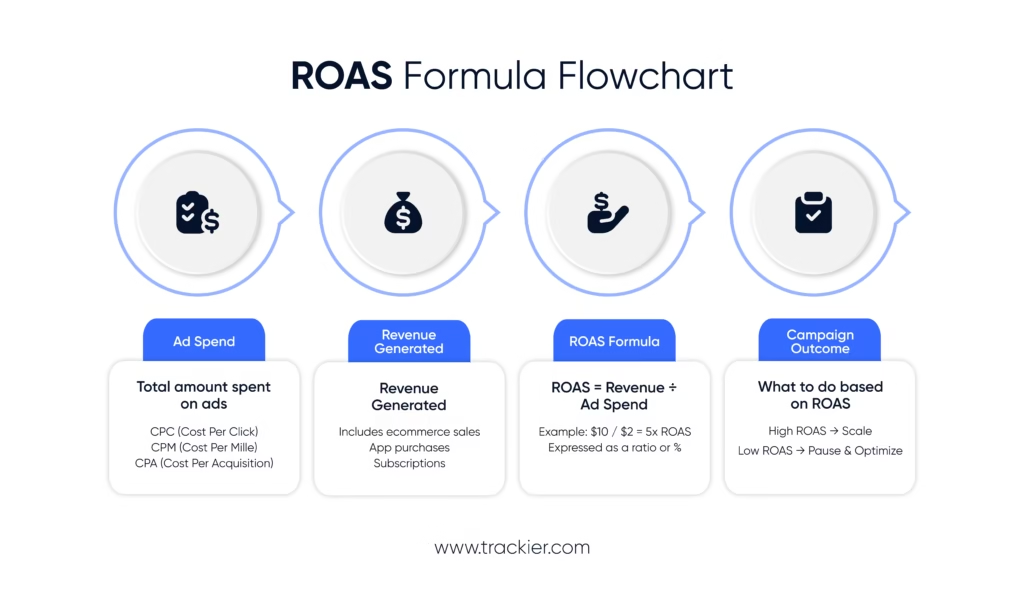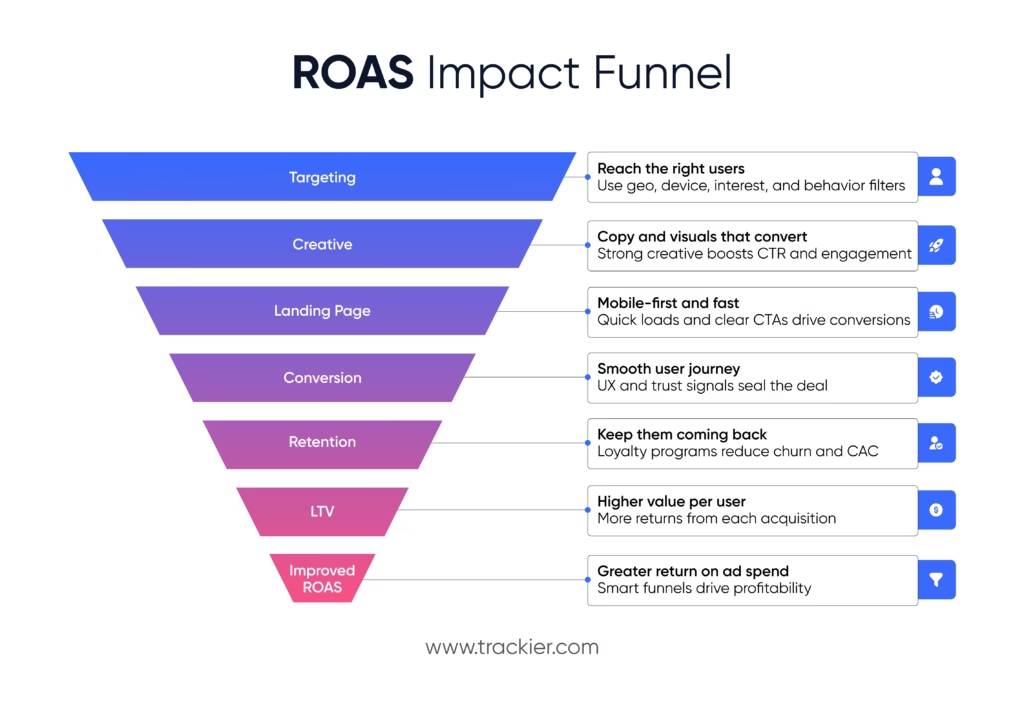What is ROAS in marketing?
ROAS, or Return on Ad Spend can be defined as one of the top performance metrics that tells you how much revenue you earn for every dollar spent on your advertising.
It is really important to track ROAS in performance marketing because it gives proper insights into the how well ad campaigns are working and how effective they actually are.
Marketers know what is ROAS and they use it to compare campaign efficiency across platforms, channels, and targeting strategies. A good and high ROAS means that your advertising efforts are generating good profits and returns, while a low ROAS can point to inefficiency or wasted spend.
Try our ROI Calculator:
Calculating ROI and ROAS manually is tedious. And spreadsheets? Not exactly thrilling. That’s why we built a quick, interactive ROI calculator right into this glossary.
Just enter your campaign spend, revenue, and a few other details. The calculator does the math instantly, showing you exactly how your campaigns are performing, no formulas, no mental math.
It’s simple, accurate, and honestly kind of addicting.
Try it out.
Track Your Campaign Wins
ROAS & Profit Calculator
What is ROAS importance for marketers in 2025?
It is 2025, and it is highly competitive, and marketers are under pressure to prove performance with measurable outcomes. This is why ROAS is more than just a profitability metric.
ROAS helps to:
- Understand which campaigns actually drive revenue
- Justify ad budgets and reallocate spend smartly
- Align marketing with business goals like ROI, CAC, and LTV
- Make real-time decisions to scale or pause campaigns
Over 70% of marketers have confessed that measuring ROAS cannot be ignored it you want to win internal buy-in for digital campaigns.
Global ad budgets are on an all time boost. According to Statista’s 2024 digital ad spend data, brands are projected to spend over $740 billion on digital channels this year alone.
What is ROAS Calculation and it’s Correct Formula?
What is ROAS formula?
The formula is simple:
ROAS = Revenue from Ads / Cost of Ads
For example, if you earn $50,000 from a campaign where you spent $10,000 on ads, your ROAS is:
$50,000 / $10,000 = 5
That means you earn $5 for every $1 spent.

What’s the difference between ROAS and ROI?
The difference lies in what you measure. In case of ROAS, it measures revenue per advertising dollar spent, whereas ROI (Return on Investment) considers profit while keeping all business costs in mind.
While both measure profitability, ROI factors in total cost and not just the ad spend. Adobe’s guide on ROI vs. ROAS breaks this distinction down with real campaign examples.
To boil it down, we can say that ROAS is more campaign-specific, while ROI is more comprehensive and business-wide.
Use Case: Use ROAS to measure ad performance. Use ROI to assess overall profitability.
What is a good ROAS in 2025?
There’s no generic benchmark to measure “ what is a good ROAS”. What’s considered a “good” ROAS depends on your industry, profit margins, and business model.
According to Neil Patel’s latest ROAS benchmarks (2024), ecommerce brands typically target a 4:1 ratio, while B2B services may settle for 2:1 due to higher customer LTV.
What are industry-specific ROAS benchmarks?
So what is ROAS target for you?
As of 2024, here’s what a good ROAS typically looks like across sectors:
- E-commerce: 4x to 10x
- SaaS: 3x to 5x (due to recurring revenue models)
- Lead generation: 2x to 4x
- Mobile apps (in-app purchases): 5x+ within 30 days
Your target ROAS should consider:
- Gross margins
- CAC (Customer Acquisition Cost)
- CLTV (Customer Lifetime Value)
- Channel and platform fees
According to Neil Patel’s latest ROAS benchmarks (2024), ecommerce brands typically target a 4:1 ratio, while B2B services may settle for 2:1 due to higher customer LTV.
You can also automate bidding with Target ROAS as the primary KPI using tools like Google Ads’ Smart Bidding strategies.

How can you improve ROAS without reducing your ad spend?
Achieving a better ROAS doesn’t mean that you have to cut your budget short. More often than not, improving ROAS means increasing efficiency rather than reducing the overall spend.
1. Refine audience targeting
Use platform-specific tools like Google Ads Audience Insights and Meta’s Lookalike Audiences to send your ads to high-intent users. Layer targeting with behavior and purchase data.
2. Optimize landing pages
Ensure your post-click experience aligns with the ad. Reports show that personalized landing pages convert 3x higher than generic ones.
3. Use high-performing creatives
Run A/B tests to identify ad designs and copy that drive higher CTR and CVR. Refresh creative fatigue regularly.
4. Automate bid strategies
Use AI-based bid optimization tools that factor in conversion value rather than just clicks. Google’s Smart Bidding, for example, adjusts bids based on likelihood of conversion and value.
5. Focus on Lifetime Value (LTV), not just short-term conversions
If your product has repeat value (SaaS, subscription, mVAS), aim for campaigns that optimize for high-LTV users even if the initial ROAS is lower. According to Google Skillshop, campaigns optimizing for LTV users see up to 40% higher ROAS over 90 days.
6. Retargeting and funnel segmentation
Serve different creatives to users based on funnel stage. It is a great idea to retarget warm leads who didn’t convert instead of wasting impressions on cold users.
One way to understand any potential outcomes before launching a campaign is by using tools like Google Skillshop’s Performance Planner. It lets you model ad performance against different spend levels so that you can understand how and what works before you put your money to it.
What tools help measure and optimize ROAS?
Which ad platforms offer built-in ROAS tracking?
Most major ad platforms offer ROAS metrics:
- Google Ads: Target ROAS campaigns, Value-based bidding
- Meta Ads: Website purchases and ROAS tracking via Pixel
- TikTok Ads: Revenue attribution via TikTok Pixel or API
- LinkedIn Ads: Lead generation ROAS for B2B
Which third-party tools support deeper ROAS insights?
Use marketing analytics platforms that integrate data from multiple sources to provide a unified ROAS view.
- Google Analytics 4: Custom attribution models
- Looker Studio: ROAS dashboards and blended channel data
- Adobe Analytics: Advanced segmentation and lifetime ROAS
- Mixpanel: Revenue-focused user journey tracking
What’s the link between ROAS, CAC, and LTV?
These three metrics are deeply connected:
- ROAS = Revenue ÷ Ad Spend
- CAC = Ad Spend ÷ New Customers Acquired
- LTV = Avg. revenue per customer x Retention time
How should marketers balance ROAS and CAC?
If your CAC is too high compared to your LTV, even a high ROAS might not be sustainable. For example:
- ROAS = 4
- CAC = $1,000
- LTV = $2,500
While ROAS looks great, you’re spending 40% of the customer’s lifetime value on acquisition. That limits profitability unless LTV increases.
The smarter move? Optimize for long-term LTV and CAC efficiency, not just short-term ROAS.
What are the limitations of ROAS?
- It only reflects ad-driven revenue, not total profit.
- It ignores backend costs like fulfilment, operations, or overheads.
- It doesn’t account for brand impact or delayed conversions.
That’s why smart marketers use ROAS alongside metrics like LTV, CAC, and ROI to get a better, overall picture.
Key Takeaways
- ROAS measures how much revenue you earn per dollar spent on advertising.
- It helps marketers assess campaign efficiency and make smarter budget decisions.
- You can improve ROAS by targeting better, optimizing creative, and focusing on long-term value.
- Tools like Google Ads, Meta Ads, and Google Analytics 4 offer built-in ROAS tracking.
- ROAS alone isn’t enough you need to track CAC, LTV, and ROI together.
If you’re just starting out, Coursera’s Marketing Analytics course is a solid primer on how to interpret ROAS alongside metrics like CAC, LTV, and blended ROI.
FAQs
1. What is ROAS?
‘What is ROAS’ is one of the most commonly asked questions for marketers. ROAS stands for Return on Ad Spend. It’s a key performance marketing metric that measures the revenue generated for every dollar spent on advertising. For example, if you spend $10,000 and earn $30,000 in revenue, your ROAS is 3:1. It tells you how efficiently your ad spend drives business growth.
2. Why is ROAS important?
ROAS is crucial because it directly links marketing spend to business outcomes. While metrics like CPC or CTR show engagement, ROAS reveals actual revenue impact. It helps marketers evaluate which campaigns, audiences, and creatives are worth scaling. A high ROAS means your campaigns are driving profitable conversions, not just clicks.
3. How do you calculate ROAS?
ROAS is calculated using the formula:
ROAS = Total Revenue from Ads ÷ Total Ad Spend
For instance, if you spent $50,000 and earned $200,000 in return, your ROAS would be 4.0 (or 400%). This tells you how many dollars you made for every dollar spent, which is undoubtedly essential for measuring campaign efficiency.
4. What is a good ROAS?
A “good” ROAS depends on your business model, margins, and customer acquisition costs. For eCommerce, a ROAS of 4:1 is often considered healthy. For high-margin SaaS, even a 2:1 ROAS can be profitable. In performance marketing, good ROAS means you’re getting more revenue than you’re spending, with enough buffer for operational costs.
5. What is a target ROAS?
Target ROAS is the minimum return you want from your ad campaigns to stay profitable. Ask yourself ‘What is ROAS target for you?’ Platforms like Google Ads allow you to set this value as part of automated bidding strategies. It helps control your cost per conversion and ensure you only scale campaigns that meet or exceed profitability thresholds.
6. How can you improve ROAS?
To improve ROAS, start by refining your audience targeting and ad creatives. Ensure your landing pages are fast, persuasive, and aligned with ad intent. Use conversion rate optimization (CRO) techniques and retargeting strategies. Tools like Trackier can help track multi-channel attribution and reduce wasted ad spend, boosting your ROAS sustainably.
Want to Know How to Maximize ROAS?
Sign up for our newsletter and get weekly tips on performance marketing.
Subscribe on LinkedIn